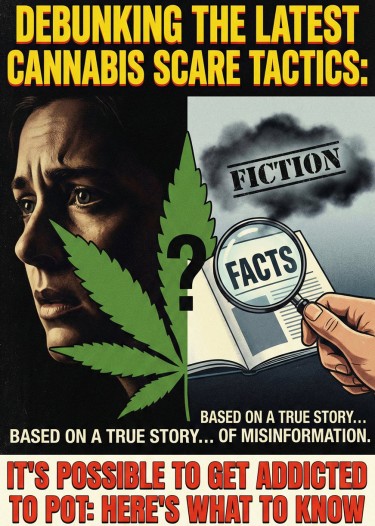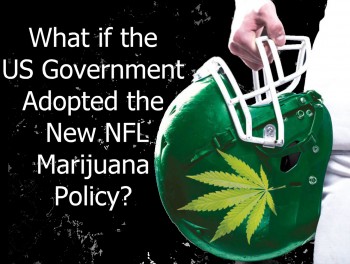
Debunking the Latest Cannabis Scare Tactics: A Critical Look at Propaganda Masquerading as Health News
Alright, let's talk about this article that's been making the rounds on multiple news outlets recently. You know the one—"It's Possible to Get Addicted to Pot: Here's What to Know." When you see the same article getting shared across multiple mainstream media platforms simultaneously, your propaganda detector should start beeping. Mine's going off like a five-alarm fire.
Look, I'm not here to tell you that cannabis is some miracle substance with zero downsides. But I am here to call out bullshit when I see it, and this article is serving up a heaping plate of it. Let's break down the claims, separate the misinformation from the actual facts, and figure out what's really going on here.
The DSM-5: Follow the Money
The article leans heavily on "Cannabis Use Disorder" as defined by the DSM-5 (Diagnostic and Statistical Manual of Mental Disorders, Fifth Edition). Sounds official, right? Sounds scientific? Well, let's pump the brakes and look at who's funding the DSM.
The reality is that a significant portion of the DSM's funding comes from pharmaceutical companies. We're talking about the same industry that stands to lose billions when people choose cannabis over their pills. The same industry that's been caught repeatedly lying about addiction potential, efficacy, and side effects of their products. The same industry that created the opioid epidemic and walked away with slaps on the wrist while millions died.
Now, here's the kicker about Cannabis Use Disorder according to the DSM-5: the diagnostic criteria are so broad that they'd technically classify nearly every moderate cannabis user as having a "disorder." Let me break this down for you.
The DSM-5 criteria include things like:
-
Using cannabis in larger amounts or over a longer period than intended
-
Unsuccessful efforts to cut down or control use
-
A great deal of time spent obtaining, using, or recovering from cannabis
-
Craving or a strong desire to use cannabis
-
Continued use despite social or interpersonal problems
Read those criteria carefully. By this standard, someone who smokes a joint every evening to unwind, occasionally thinks "I should cut back," and spends time going to the dispensary has a "disorder." Someone who really enjoys their weekend smoke sessions and looks forward to them all week? Disorder. Someone who continues using cannabis despite their judgmental mother-in-law giving them grief about it? Disorder.
See the problem? These criteria are so vague and so broadly applicable that they pathologize normal human behavior. By this logic, we should all be diagnosed with Coffee Use Disorder, Social Media Use Disorder, and Netflix Binge Disorder.
When you have a diagnostic manual funded by an industry that profits from keeping cannabis illegal and demonized, you should take those diagnoses with a massive grain of salt—especially when it comes to substances that compete with their products.
The Potency Myth: Let's Get Real About THC
The article trots out the tired old claim about cannabis being "up to 40%" more potent than it was in the 1960s. This is one of my favorite prohibitionist talking points because it's both technically true and completely misleading at the same time.
First, let's address the historical context. Yes, a lot of the cannabis that circulated in the 60s and 70s was relatively weak by today's standards. But pretending that high-potency strains didn't exist back then is revisionist history. Strains like Jamaican Red, Acapulco Gold, Panama Red, and Thai Stick were legendary for their potency. These weren't your average strains—they were the top-shelf stuff that people sought out specifically because they were stronger.
But here's where I want to focus: that "up to 40%" claim. Notice the weasel words there—"up to." This is classic fearmongering language that creates a false impression.
When you actually look at the statistics of cannabis sold in legal dispensaries across the United States, the average THC content in flower is nowhere near 40%. We're talking about averages in the 15-25% range, depending on the state and the testing methodology. And here's where it gets interesting: there's been extensive documentation of dispensaries and testing labs overestimating potency.
Why would they do this? Because in an unregulated market, higher THC numbers sell better. Consumers have been conditioned to think that higher THC automatically means better product, so labs have an incentive to inflate numbers to help their clients move product. Multiple investigations have exposed this practice, showing that the actual THC content is often significantly lower than what's listed on the label.
So when the article throws around that "up to 40%" number, they're citing the absolute highest end of the spectrum—probably including concentrates and dabs, not just flower—and presenting it as if it's representative of what most people are consuming. It's not.
And let's be honest about what this fear about potency really means: it's just another version of "kids these days" moral panic. Yeah, cannabis is stronger now. You know what else is stronger now? Beer. Wine. Liquor. We have 90-proof whiskey and 15% ABV craft beers, but nobody's writing panic articles about how alcohol is too strong these days. Why? Because alcohol is socially acceptable despite being far more dangerous.
The Statistics Game: How to Lie with Numbers
Here's where the article really goes off the rails: "According to the latest version of the National Survey on Drug Use and Health, 7% of all people 12 or older had cannabis use disorder in 2024 and most had a mild form. About 1 in 5 had a severe form."
Let's do some quick math here. They're saying 7% of people 12 and older have cannabis use disorder. Then they say about 1 in 5 of those have a severe form. So we're talking about roughly 1.4% of the total population having what they classify as "severe" cannabis use disorder.
But here's the thing: even in the same article, they contradict this broad-stroke diagnosis. Dr. Das, who they quote extensively, admits: "Marijuana doesn't affect everyone the same way, though. The same amount can have 'major impacts' on one person's daily life but have no impact on another person's. It really comes down to: How much is that substance impacting someone's functioning and life day-to-day?"
Wait, what? So you're telling me that the diagnosis is completely subjective and depends entirely on individual circumstances, but you're comfortable slapping a "disorder" label on 7% of the population based on broad criteria?
This is the problem with these statistics. They're using overly broad diagnostic criteria, applying them inconsistently, and then presenting the results as if they represent objective medical reality. It's the statistical equivalent of measuring everyone's body temperature, deciding that anything over 98.6°F is a "fever disorder," and then being shocked when a huge percentage of the population qualifies.
The truth is that the "severe" cannabis use disorder they're describing applies to a tiny fraction of cannabis users—people who genuinely struggle to function because of their consumption. These people exist, they need help, and we shouldn't shame them. But they're not 20% of cannabis users. They're not even close.
What They Got Right (Sort of)
I'll give credit where it's due: the coping mechanisms and strategies they suggest for people who want to quit or cut back on cannabis use are actually pretty reasonable. Things like identifying triggers, finding alternative activities, seeking support, and being patient with yourself are all solid advice for anyone trying to change any habit.
The problem is that they're presenting these strategies as if they're necessary for the majority of cannabis users, which is simply not true. Most people who consume cannabis do so responsibly, derive benefits from it, and don't need to quit or even cut back.
The Real Talk About Cannabis Addiction
Here's the honest truth that gets lost in all the propaganda and fearmongering: some people do develop problematic relationships with cannabis. It happens. It's real. These people deserve help, not shame.
Cannabis addiction is possible, but it's significantly rarer than these statistics suggest. When you strip away the inflated diagnostic criteria and the pharmaceutical industry's financial interest in demonizing cannabis, you're left with a small percentage of users who genuinely struggle with dependence.
And yes, people can get addicted to all sorts of things. Some addictions are definitely worse than others—nobody's dying from cannabis withdrawal the way they die from alcohol or heroin withdrawal. But that doesn't mean we should dismiss people who are struggling with cannabis use.
The problem is that articles like this one don't actually help those people. They don't provide nuanced, honest information about risk factors, warning signs, or effective interventions. Instead, they throw around scary statistics and broad generalizations that create stigma and panic rather than understanding.
The Propaganda Pattern
As I've gotten older, I've become increasingly cynical about these coordinated media campaigns. When the same article starts making rounds across multiple news outlets at the same time, you have to ask: why now? Who benefits from this narrative?
We're seeing a clear pattern here. The Trump administration has signaled its intention to crack down on cannabis. The pharmaceutical industry stands to benefit from keeping cannabis illegal or heavily restricted. And suddenly, right on cue, we get a wave of articles about how dangerous and addictive cannabis is.
It's not subtle. It's not even particularly clever. But it works because most people don't have the time or inclination to dig into the actual research, follow the money, or question the narrative they're being fed.
The Sticky Bottom Line
Look, we need to be honest about cannabis if we actually want to help people make informed decisions. That means acknowledging both the benefits and the risks. It means admitting that yes, some people develop problematic use patterns. But it also means calling out bullshit statistics, pharmaceutical industry influence, and coordinated propaganda campaigns when we see them.
This article that's been making the rounds is not honest health information. It's a carefully crafted piece of propaganda designed to support a renewed war on cannabis users. The timing isn't coincidental. The exaggerated statistics aren't accidental. The broad diagnostic criteria that pathologize normal behavior aren't just sloppy science.
This is narrative control. This is manufacturing consent for prohibition. This is the same playbook they've been using for decades, just with a fresh coat of paint and some updated jargon.
So when you see these articles being shared, when your aunt posts them on Facebook with a concerned comment about "the dangers of marijuana," take a moment to think critically. Ask who benefits from this narrative. Follow the money. Question the statistics. And maybe, just maybe, share a more nuanced perspective.
Because the people who actually need help with cannabis use aren't served by propaganda and fearmongering. They're served by honest information, accessible resources, and a society that doesn't treat them like criminals for making choices about their own bodies.
As for the rest of us? We're served by recognizing propaganda when we see it and refusing to let it go unchallenged. Consider this your PSA: the cannabis panic is back, and you're going to need to defend against this drivel.
Stay informed. Stay skeptical. And stay free.






